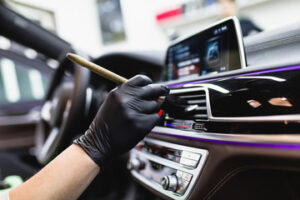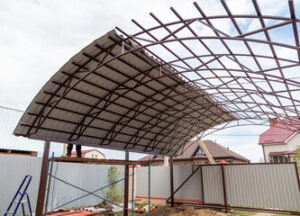Mobile Auto Detailing is a home service that appeals to busy people who want convenience, speed and excellent results.

This article will cover all the steps required to get started with a successful mobile detailing business, including start-up costs and necessary tools and equipment. It also includes tips for scalability and efficiency. Visit Website to learn more.
Full-service mobile detailing brings the complete cleaning, restoration, and protection services of a car dealership or auto body shop right to your driveway. This convenient, efficient, and comprehensive approach to maintaining the beauty of your vehicle ensures it is always at its best, without ever having to go out of your way to a service center.
Full exterior mobile detailing starts with a thorough washing, removing dirt and debris that has accumulated over time. This includes the removal of tar, bug remains, road grime, and more, as well as cleaning the wheel wells, tire rims, door jambs, and gas cap. Once the vehicle is completely dry, the detailer applies a protectant to the paint surface, which helps to reduce the amount of dirt and debris that can stick to the vehicle in the future.
The detailer may also use a clay bar to help remove any contaminants that have stuck to the clear coat or broken through it, such as sap, bird droppings, road grime, and more. Once the paint is thoroughly clean, it will be treated with a high-quality wax or sealant to help keep the surface protected from the elements.
Window and mirror cleaning is another crucial part of the full exterior detailing process, as it can greatly improve visibility and safety. Detailing professionals utilize specialized techniques and industry-grade products to ensure windows, mirrors, and glass surfaces are smudge-free and crystal clear.
Another important part of the full interior and exterior detailing process is removing any large items from the vehicle, such as gym bags, work clothes, food containers, and more. This helps to prevent the vehicle from becoming too cluttered, which can lead to diminished performance and safety.
Keeping your vehicle in tip-top shape can feel like a full-time job. To ease this stress and make it easier to maintain, a ceramic coating from MRG Mobile Detailing can be applied to the surface. The hydrophobic properties of the coating repel contamination, make hand-washing a breeze, and protect against UV rays that can damage the surface over time. As a result, your car will stay glossy and beautiful for the long term.
Interior
The interior of a vehicle needs special attention to make it look its best. Mobile detailing professionals can wipe down cup holders, air vents, dash and console surfaces. They can also clean and vacuum seats and carpets. If you have leather, they can apply a conditioner to prevent sun damage. They can also remove pet hairs. Depending on your budget and time, you may want to choose extra services like paint protection film or ceramic coating.
Both mobile and shop detailers should have standard safety gear. This includes protective gloves, respirators, sidewinders, face masks, and caps. It is also important to have the right tools to do your job. For example, a professional steam car wash will dissolve gunk much faster than water and a brush. This will save you a lot of time. It will also save you money because you will not need to buy a chemical-based cleaner.
Mobile auto detailing businesses can be less expensive than a traditional brick-and-mortar shop. They typically have lower startup costs and can be established quickly. You can even start with just a van and some cleaning supplies and equipment. You can also use a business software system to streamline management tasks, such as marketing, invoicing, payments, and contacts. This can help you run a profitable detailing business and stay on track with your goals.
If you’re considering opening a mobile car detailing business, do your research first. Look at competitors in your area and find out what customers are looking for. If you can offer something that no one else is, you’ll have a better chance of making your business successful.
A mobile detailing business allows you to work around your schedule and travel to different locations. This is a great option for busy people who don’t have the time to drive their vehicles to a car wash. It also provides flexibility if you decide to change your business model in the future.
The key to a successful mobile auto detailing business is to plan carefully and invest wisely. Ensure you have all the necessary licenses and paperwork in place before starting. You should also be sure to hire employees with the right skills and knowledge. Moreover, you should develop a business strategy and set clear expectations for your employees.
Tires
Of all the surfaces in your car, your tires take the biggest beating. They endure rough roads, sand and salt, acid rain, snow, and other contaminants, and they need regular care to stay in good shape. When detailing your vehicle, make sure you use a tire cleaner with a high pH level to avoid damaging the rubber. You can also choose a tire dressing to protect the rubber against fading, cracking, and discoloration caused by UV rays.
Choosing a reputable mobile auto detailing service is essential for keeping your car in pristine condition. A detailer will treat every nook and cranny, leaving no dirt behind. They will use only the best products and techniques to achieve top results. A professional will be able to work on your car anywhere and at any time, making it convenient for you.
If you have a busy lifestyle, hiring a professional mobile detailer is a great way to keep your vehicle looking its best. Mobile detailers can provide services for all your needs, from washing and vacuuming to shampooing the interior and cleaning the tires. They can even add ceramic coating or PPF to your vehicle, which offers a more comprehensive protection than wax.
Before the detailing process begins, it’s important to remove all accessories that could scratch or damage the surface of your vehicle. This includes long necklaces, bracelets and watches, rings, fanny packs, and chastity belts. Also, remember to turn off your cell phone and any other devices that can distract you from the task at hand.
Headlights
Headlights are a vital safety feature of your vehicle. They allow you to see the road in front of you when it’s dark, as well as help other drivers to recognise your car and gauge how close or far away it is. Modern headlamps are electrically operated and produce both a low and high beam. They are usually positioned in pairs at the front of your vehicle, with one on each side. High-beam headlamps are very bright and will blind other traffic if switched on too frequently. It is recommended to only use them when the road ahead is clear and there are no other vehicles present on the road.
Most headlamps are made of polycarbonate plastic. They are covered at the factory with a protective finish, which is also a UV absorber. Over time this coating can break down causing the headlights to become milky or yellow. This is an aesthetic issue but can be more dangerous as it restricts the amount of light they can produce, creating a potential hazard for other road users.
There are a variety of headlight bulbs on the market, from halogen to xenon. Xenon bulbs are more expensive than halogen and take longer to reach full brightness, but they produce a much brighter light and are able to cut through fog, mist, and snow. Halogen bulbs are cheaper but require a higher voltage to ignite the filament and will burn out quicker than Xenon.
Another option is LED headlights which are very bright and can illuminate a wider area than traditional bulbs. They are also more energy efficient than halogen and Xenon bulbs, but they may not be as bright as a halogen bulb.
If your headlights are cloudy or yellow, Pinehurst Mobile Detailing can restore them to their original condition using a process developed by Bright Solutions. This method is more effective than DIY headlight restoration techniques and can guarantee better visibility when driving at night. We can even apply a sealant to your headlights to protect them from future damage, leaving them looking as good as new.

